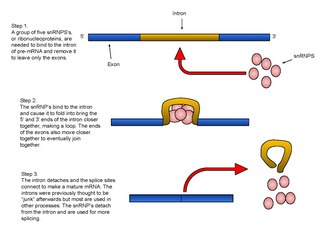An exon is any part of a gene that will encode a part of the final mature RNA produced by that gene after introns have been removed by RNA splicing. The term exon refers to both the DNA sequence within a gene and to the corresponding sequence in RNA transcripts. In RNA splicing, introns are removed and exons are covalently joined to one another as part of generating the mature messenger RNA. Just as the entire set of genes for a species constitutes the genome, the entire set of exons constitutes the exome.

Alternative splicing, or differential splicing, is a regulated process during gene expression that results in a single gene coding for multiple proteins. In this process, particular exons of a gene may be included within or excluded from the final, processed messenger RNA (mRNA) produced from that gene. Consequently, the proteins translated from alternatively spliced mRNAs will contain differences in their amino acid sequence and, often, in their biological functions. Notably, alternative splicing allows the human genome to direct the synthesis of many more proteins than would be expected from its 20,000 protein-coding genes.

A protein isoform, or "protein variant" is a member of a set of highly similar proteins that originate from a single gene or gene family and are the result of genetic differences. While many perform the same or similar biological roles, some isoforms have unique functions. A set of protein isoforms may be formed from alternative splicings, variable promoter usage, or other post-transcriptional modifications of a single gene; post-translational modifications are generally not considered. Through RNA splicing mechanisms, mRNA has the ability to select different protein-coding segments (exons) of a gene, or even different parts of exons from RNA to form different mRNA sequences. Each unique sequence produces a specific form of a protein.
Post-transcriptional modification or co-transcriptional modification is a set of biological processes common to most eukaryotic cells by which an RNA primary transcript is chemically altered following transcription from a gene to produce a mature, functional RNA molecule that can then leave the nucleus and perform any of a variety of different functions in the cell. There are many types of post-transcriptional modifications achieved through a diverse class of molecular mechanisms.
A splice joint is a method of joining two members end to end in woodworking. The splice joint is used when the material being joined is not available in the length required. It is an alternative to other joints such as the butt joint and the scarf joint. Splice joints are stronger than unenforced butt joints and have the potential to be stronger than a scarf joint.

U12 minor spliceosomal RNA is formed from U12 small nuclear (snRNA), together with U4atac/U6atac, U5, and U11 snRNAs and associated proteins, forms a spliceosome that cleaves a divergent class of low-abundance pre-mRNA introns. Although the U12 sequence is very divergent from that of U2, the two are functionally analogous. The predicted secondary structure of U12 RNA is published, but the alternative single hairpin in the 3' end shown here seems to better match the alignment of divergent Drosophila melanogaster and Arabidopsis thaliana sequences. The sequences U12 introns that are spliced out are collected in a biological database called the U12 intron database.

Fast skeletal muscle troponin T (fTnT) is a protein that in humans is encoded by the TNNT3 gene.

Plasma membrane calcium-transporting ATPase 3 is an enzyme that in humans is encoded by the ATP2B3 gene.
ASPicDB is a database of human protein variants generated by alternative splicing, a process by which the exons of the RNA produced by transcription of a gene are reconnected in multiple ways during RNA splicing.
TassDB is a database of tandem splice sites of eight species
Alternative Splicing Annotation Project (ASAP) is a database for alternative splicing data. The purpose of this project was to provide a source for data mining projects by consolidating the information generated by genomics and proteomics researchers.
The Alternative Splicing and Transcript Diversity database (ASTD) is a database of alternative transcripts containing transcription initiation, polyadenylation and splicing variant data.
ECgene is a database of genomic annotations taking alternative splicing events into consideration.
EDAS was a database of alternatively spliced human genes. It doesn't seem to exist anymore.
The Human-transcriptome DataBase for Alternative Splicing (H-DBAS) is a database of alternatively spliced human transcripts based on H-Invitational.
The Intronerator is a database of alternatively spliced genes and a database of introns for Caenorhabditis elegans.
ProSAS is a database describing the effects of splicing on the structure of a protein
SpliceInfo is a database for the four major alternative-splicing modes in the human genome
WormBase is an online biological database about the biology and genome of the nematode model organism Caenorhabditis elegans and contains information about other related nematodes. WormBase is used by the C. elegans research community both as an information resource and as a place to publish and distribute their results. The database is regularly updated with new versions being released every two months. WormBase is one of the organizations participating in the Generic Model Organism Database (GMOD) project.





